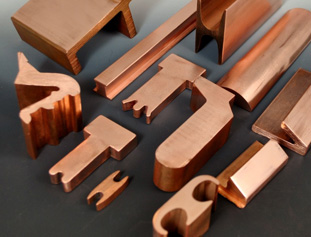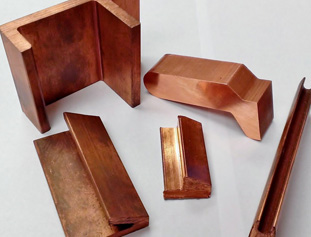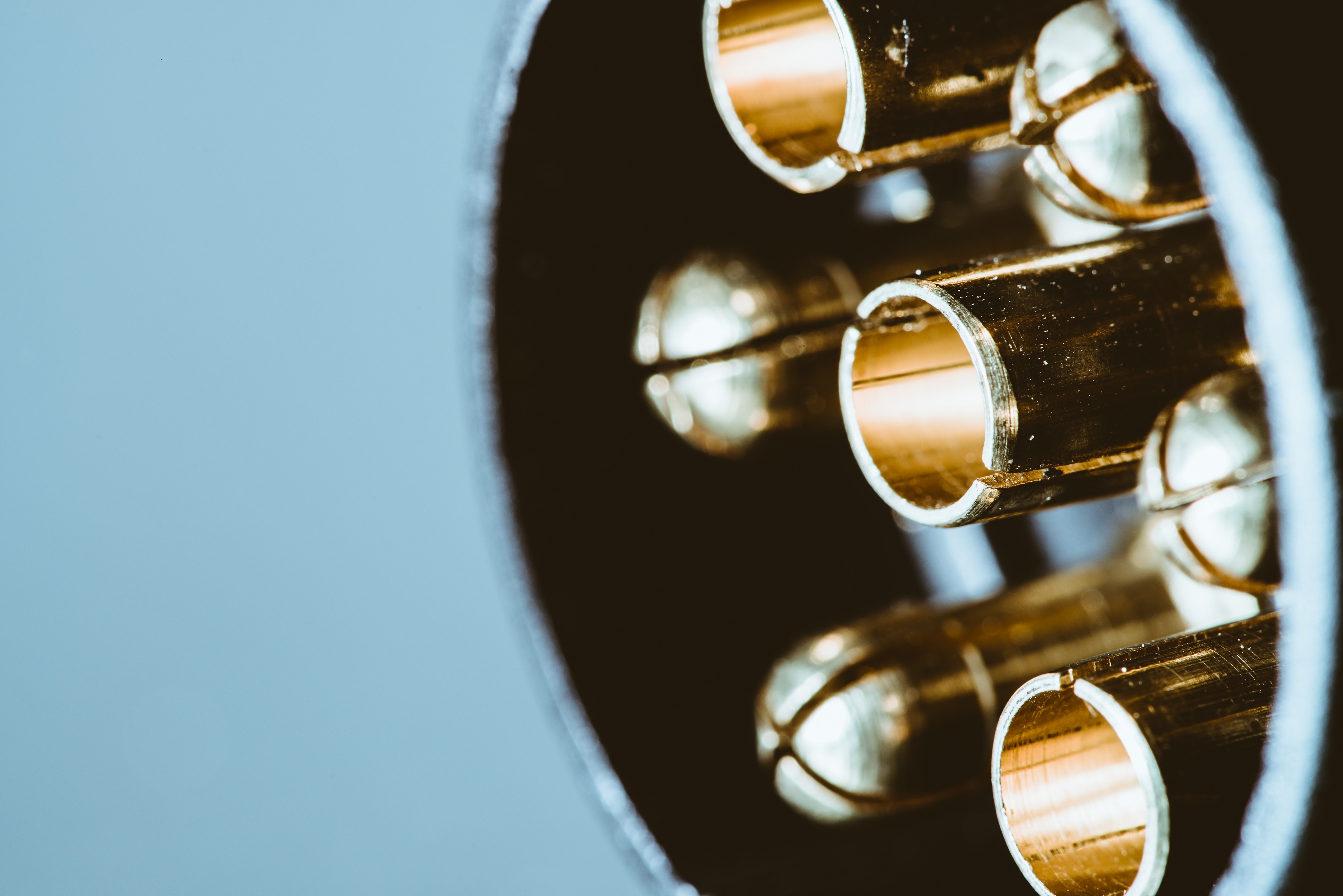Forging vs Extrusion: A Comparative Guide of Two Shaping Methods
Leave a Comment
When you want to manufacture copper parts and components, there are multiple ways to achieve the same results. Forging and extrusion are 2 reliable methods. Here is a comparative guide illustrating the differences between forging copper and making custom copper extrusions.
Forging
When using a forge, you use massive amounts of compressive force to press a solid piece of copper or other metal into the shape you desire. The raw copper, called a billet, is shaped by a custom-made steel die. Forging methods vary depending on the process temperature (hot or cold) and style of die (open or closed). Mechanically, forged copper parts are exceptionally strong and have tremendous structural integrity. This is because the raw copper material is put through high pressure which creates deformation. Deformation causes the copper to conform to the desired shape via metallurgical recrystallization and grain refinement.
Forged copper is less labor intensive and leaves less scraps behind than copper extrusions. The extreme pressure from the forge creates a smooth surface and eliminates any cavities or voids within the finalized copper part. Forged copper parts are highly reliable and consistent in strength, shape, and flexibility.
With the exception of closed die forging, all other methods have difficulty meeting the strict tolerance requirements copper and other metals need when being shaped. This can lead to a lot of secondary processing to successfully create the finished shape, especially if you use the open die forge method. Plus, open forging does not always work when you want to make a complex or intricate shape using copper or other metals.
Extrusion
The process of extruding copper involves a high-pressure press that forces the raw billet through a die typically known as an outlet. The die is composed of small or differently-shaped cross-sections that match the shape you want or need to be extruded. These shapes can be as long as you want or need them to be, with the standard length at 12 feet. The extrusion process can create several properties and produce elongated grain structures that increase the raw copper’s mechanical strength.
The best copper extrusion methods are hot extrusion and cold extrusion. Hot extrusion involves heating the copper billet above the temperature at which the metal would normally crystallize. Such high temperatures rid the copper of pores and voids, breaks up formations, and creates a smoother structure. Cold extrusion shapes copper at the temperature of the room or area the machinery is kept in. This gives the final shape a better finish on the surface and adds strength through strain hardening.

You can also extrude copper and other metals directly or indirectly. Indirect extruding involves pushing raw copper through a work chamber using a ram to push the material through a special die made of steel. Indirect extrusion involves fully containing raw copper in a chamber with a built-in hollow ram that the material is pushed through or formed over. The machines used in extrusion methods can be made by a reputable copper extrusion manufacturer or purchased from reliable copper extrusion suppliers.
Extrusion methods are ideal for creating long, tubular metal structures like hand rails that can be cut into smaller pieces if necessary. There is a low yield of scraps from the machines and they work quickly and efficiently. The finalized copper forms have incredibly consistent cross-sections that is helpful for parts that need a certain mechanical property or pressure rigidity. The forms also have improved impact resistance, flexibility, and strength.
If you have any other questions about the copper extrusion method, visit the Hoyt online today.
Understanding Electrical Contact and Its Application
Leave a Comment
Electrical contacts are ever-present in just about everything we use every day. If a piece of equipment, machinery, device or appliance runs on electrical current, there are several electrical contacts powering the current. Here is a brief tutorial of what electrical contacts are and what they’re used for.
The Basics
An electrical contact is the part of an electrical circuit that completes the power circuit to allow electrical current to flow from point A to point B. When the power circuit opens, that current flow stops; when it closes, the connection is complete, and the current flow powers the electrical machinery being used.
Electrical contacts are used in power distribution applications such as; switches, circuit breakers and relays. Diesel-electric trains, light rail vehicles, historic trollies, nuclear submarines, electric cars, mining trucks, oil and gas drilling motors and basic applications such as a light switch or small appliances.
Electrical contacts and the contact tips are made from a range of materials, based on several variables.
Materials and Why They Are Used
Copper is the common material used for electrical contact backings. The powder metal contact tip is the conduit for the power circuit to complete the flow of power. When selecting materials for the contact tip, the goal is to get the optimal voltage and wear from the material that gives the electrical component the highest ratio of success. A general rule of thumb is that as conductivity increases, resistance decreases. The thermal conductivity rises, but erosion also increases. For example, a silver electrical contact tip is brazed to a copper backing and is a superb conductor, but because the tip is pure silver, the silver tip can degrade and erode quicker. For that reason, even if silver electrical contacts are the least expensive electrical contact tips available, there are alternative metals to be added to the silver to increase the longevity of the electrical contact part.
An electrical contacts manufacturer can mix the silver with metals like carbide and tungsten to make the powder metal contact tips more conductive, resistant and last longer. Often silver electrical contact suppliers offer silver carbide and silver tungsten contacts because these metals combine superior conductivity of the silver with the ability of carbide and tungsten to withstand mechanical and electrical wear for longer periods of time. These tips will cost more upfront but if your train, mining truck or drilling motor runs longer with less downtime, you are saving money in the long run.

There are other materials used for electrical contact tips based on the power and voltage requirements of the devise. Other electrical contact tip materials include:
Gold: It’s highly conductive but very malleable.
Silver Tungsten Carbide: It’s resistant to contact sticking, welding, and oxidation. Because it’s a harder material, it’s more resistant to arc erosion and contact wear.
Copper: Copper is highly conductive and durable.
Copper Tungsten: This is a low-cost alternative to silver tungsten or carbide. These are used in applications such as oil and gas filled devices.
Other materials used in contact tips include silver graphite, silver tungsten carbide graphite, silver molybdenum, silver nickel, and copper graphite.
Electrical contacts have become highly specialized and can be applied to components to achieve optimal functionality, longevity, and effectiveness. The type of powdered metal electrical contact tip for the electrical contact depends on the applications power requirements. For more information about which electrical contact and powder metal tip to use for your application needs, visit Hoyt.
